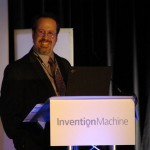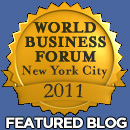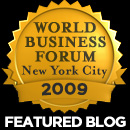Nov03
Northrop Grumman, Eastman Chemical: Where to Innovate in this Economy
Point: “Where” innovation comes from can be a place, a time, or a conceptual process.
Story: At Invention Machine’s Power to Innovate user conference, Jim Belfiore, Senior Director of Client  Innovation and Practices, posed the question of where to innovate in this economy. Numerous presenters provided varied and surprising answers about where they find innovation and innovation-related opportunities.
Innovation and Practices, posed the question of where to innovate in this economy. Numerous presenters provided varied and surprising answers about where they find innovation and innovation-related opportunities.
First, “where” can be a literal place. Mark Atkins, CEO of Invention Machine, discussed research on emerging markets such as China, India, Brazil, and other rapidly-developing emerging markets. He cited data on the rise of innovation awareness and investment in these countries. For example, a recent survey found that 52% of executives in emerging markets thought innovation was critical versus only 31% in the US and EU. The same survey showed that more executives in emerging markets are investing in innovation than are their mature-market counterparts (85% vs. 53%).
The implication: companies should scan and analyze emerging markets for companies that might be disruptive competitors or that might become the company’s new suppliers, new manufacturers, or new distributors for addressing emerging market needs. By answering “where” with emerging market players, companies can find new opportunities for collaboration.
Second, Dr. Charles Volk, Vice President and Chief Technologist at Northrop Grumman Navigation Systems, showed how innovation can be found in the past — “where” can be a point in time. Volk’s division makes high-performance inertial navigation systems that enable aircraft and missiles to know exactly where they are, how fast they are moving, how they are oriented in space, and which way they are heading. The devices represent more than 50 years of technological success, as well as some failures. Failures of the past, however, can be resurrected when new technology advances and obviates previous constraints. The key, however, is to be able to access the prior work a company has done on a project, to avoid reinventing the wheel. The challenge gets even bigger given that so many Boomers are retiring, taking past knowledge and lessons learned with them. That’s one reason why Northrop used Invention Machine’s Goldfire tool to systematically capture and index legacy knowledge from disparate sources and formats. According to senior scientist David Rozelle, for example, “Extensive efforts were put into feeding all HRG [Hemispherical Resonator Gyro] product-line documentation into state-of-the-art-knowledge base tools, including Invention Machine’s Goldfire system, to allow future engineers easy access to this huge amount of information through queries to the database.”
Third, Henry Gonzalez, Technology Fellow at Eastman Chemical Co, provided an external-source “where” example. Eastman, a global manufacturer of chemicals, plastics and fibers, wanted to find a new application for one of its existing technologies. Eastman used Goldfire’s Innovation Trend Analysis and semantic capabilities to identify and target likely conferences and papers that could point to an answer. The results? A two-day effort using Goldfire yielded results that took an Eastman engineer 6-9 months to do previously. Eastman engineers were originally skeptical that a tool could help them be more innovative, but they were convinced by the results and are now expanding their Goldfire deployment.
Finally, Belfiore challenged people to look beyond their current S-curve of technology or product adoption to the next curve. More specifically, his answer to the question of “where” is to examine where your current constraints are. Then look to that as “where” to innovate before a competitor does. For example, in the energy industry, hydrocarbon production and supply are a challenge, with the constraints of cost, resources and environment impact. Most alternatives to the energy issue target eliminating hydrocarbon fuels by substituting wind or sun. But these next-generation solutions come with new problems, such as replacing the world’s fleet of vehicles and existing energy-delivery infrastructure if liquid hydrocarbons are no longer used. Joule BioTech, however, pinpointed fuel as its innovation place. Specifically, Joule focused on finding a new way to make hydrocarbon fuel that would reduce dependence on foreign oil and eliminate the carbon footprint of fuel. Joule disrupted the way fuel is made. Rather than start with a hole in the ground to reach fossil fuels, Joule created sunlight-driven bioreactors that could grow artificial microbes that produce ethanol and diesel. The microbes require only sunlight and carbon dioxide to produce ethanol and diesel, thus not only lowering the cost of production but also removing CO2 from the atmosphere. When the fuel and diesel is burned in the car engine, therefore, no new CO2 is released. And, the fuel is used in the combustion engine just like gasoline, requiring no new infrastructure.
Action:
- Think about all the possible “wheres” of innovation.
- Look at the past for failed innovations that you can resurrect using new developments or to address new needs.
- Look at new markets and the new players arising in those markets as a new source, new collaborator, or new point of demand for innovation.
- Look beyond the current S-curve to create the next S-curve before the competition does.
For more information, on Northrop Grumman’s HRG project, see: http://www.es.northropgrumman.com/media/whitepapers/assets/hrg.pdf
Comments Off on Northrop Grumman, Eastman Chemical: Where to Innovate in this EconomyCase study, Growth, How-to, Innovation, International, New Product Development, Opportunity, Software tool, Strategy










